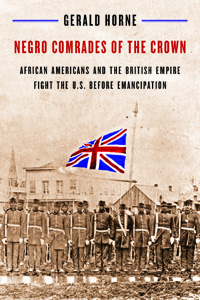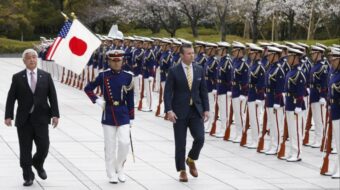
Traditional U.S. histories emphasize the revolutionary, progressive nature of the birth of our nation in its struggle against the British crown. Consequently, 1776 is seen by most as a watershed moment for freedom and democracy. However, Gerald Horne’s Negro Comrades of the Crown: African Americans and the British Empire Fight the U.S. Before Emancipation turns this historical narrative on its head.
Instead, Horne focuses on the reactionary nature of U.S. slavery and racism, and demonstrates – quite conclusively – the vanguard role of African Americans in the struggle for freedom, human rights and the expansion of democracy, as well as the British Empire’s aid in the struggle to defeat slavery.
Just a few years after the Revolutionary War and the consolidation of power by the “slaveholders’ republic,” Horne writes, the new government continued to fear “[t]he awesome combination of the armed forces of what might have been the most militarily sophisticated nation on the planet [the British Empire] and a highly motivated internal insurgency by enslaved Africans.”
In fact, former slaves in British red coats often took up arms against their former masters. “The very sight of them [former slaves in British uniform] seemed to augur the dreaded reckoning, payback for well-nigh centuries of brutalization,” Horne writes.
Yet, as was increasingly the case, “local authorities were handicapped” in confronting the British and African American advances “due to the need to guard against a revolt of the [still] enslaved.” For example, Virginia – “perceived widely as the power behind the throne of the slaveholders’ republic” – “had to contend with the difficult decision of determining if it should respond more forcefully against Africans, the internal foe, or redcoats, the external one.”
That a “redcoat invasion … coupled with an assisted revolt of the enslaved” would undoubtedly lead to a “depleted militia,” an “unarmed militia,” a “fleeing militia” and ultimately a “militia with low morale” was widely understood among slaveholders – if widely forgotten, or ignored, by most historians today – should come as no surprise given the brutality of the slave system.
“By one estimate, of the 12,000 British troops [that invaded] New Orleans [during the war of 1812], 1,400 were African,” writes Horne, and many of those were former slaves who acted as “the tip of the spear of the occupying forces” in what was considered “part of their [Britain’s] shock and awe strategy.”
The prospect of an internal revolt of the enslaved bolstered the British Empire’s designs on their former colony, the “slaveholders’ republic.” Likewise, the projection of British abolitionism – and the reality of free blacks leading their own governments in lands considered British territory – also bolstered African Americans’ plans for revolt.
As the British Empire’s direct military confrontations with the “slaveholders’ republic” diminished, it found other, more inventive ways to aid slaves who struck out for freedom. For example, when “scores of slaves” aboard the vessel Creole revolted and demanded that they be taken to the Bahamas – a British territory – a “severe crisis” erupted, Horne writes. The “slave South was in an uproar,” as once the formerly enslaved made their way to British territory they would be freed, sending a clear message to all slaves en route to captivity. A large contingent “led by the U.S. consul had appeared [in the Bahamas] with the idea of boarding the Creole with arms, [to] rescue the remaining ‘property.'” However, a “company of 24 men stood on deck with loaded muskets in hand and violent engagement in mind,” which sent the consul and his “angry entourage” packing.
Frederick Douglass, probably the most well-known abolitionist in U.S. history, called the Creole incident “a bombshell.” “In the event of a British army landing in the [United] States, and offering liberty to the slaves,” Douglass said, the slaves “would rally around the British at the first tap of the drum,” a reality arousing much fear among slaveholders.
As the “irrepressible conflict” between the North and South grew, ultimately leading to the Civil War, and as abolitionism grew in the U.S., the sentiment among enslaved and free African Americans towards the British Empire changed very little. As one African American put it at an abolitionist convention just years before the Civil War: “I would hail the advent of a foreign army upon our shores, if that army provided liberty to me and my people in bondage.” It was “evident that the army he had in mind” was the British Empire’s, Horne writes.
Negro Comrades of the Crown is a much welcomed addition to our understanding of U.S. history. As it makes abundantly evident, U.S. blacks – free and slave – were in the vanguard in the struggle for freedom, human rights and expansion of democracy. That the British Empire played a significant role in this process adds a more nuanced dimension to our understanding of U.S. history, complicating the usual one-dimensional view of our revolution, which is normally seen as an affront to reaction rather than in some ways an affront to freedom.
Negro Comrades of the Crown should be required reading.
Book information:
“Negro Comrades of the Crown: African Americans and the British Empire Fight the U.S. Before Emancipation”
By Gerald Horne
New York University Press, 2013, paperback, 365 pages










